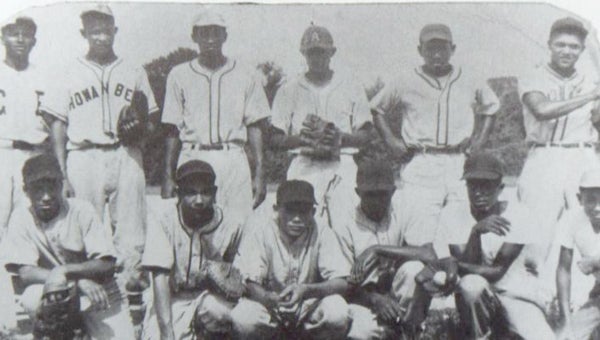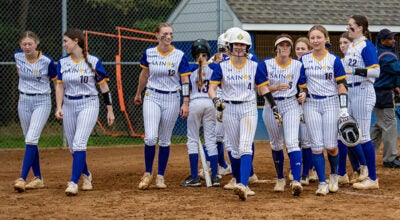Recalling the ‘Cornfield Boys’ of N.C.
Published 9:49 pm Tuesday, September 2, 2014

The Chowan Bees were one of the three northeastern North Carolina teams that featured some of the best black baseball talent around.
By Frank Roberts
Note: This story is based on excerpts from “They Called Us Cornfield Boys,” written by Raymond Whitehead, a former Cornfield player, whose grandfather founded the Ahoskie War Hawks, and by a friend, E. Frank Stephenson Jr., and on interviews I conducted in 1995 in Murfreesboro, N.C., with 10 of the players at a Cornfield reunion. The men were in their 70s. The other teams were the Como Eagles and the Chowan Bees of Winton.
“The Negro major league teams rolled into Hertford County and talked junk to the local teams, calling them such names as Cornfield Boys, Log Rollers, Watermelon Pickers, Hog Wrestlers, Brown Mules and other trash. The three local teams responded by beating every team from the Negro major leagues.”
— “They Called Us Cornfield Boys”
The mainline press avidly covered the exploits of the American and National League teams. Black-owned newspapers covered such teams as the New York Black Yankees and the Baltimore Elite Giants.
But in northeastern North Carolina, coverage ranged from wee to zilch for the teams that went to bat for the home folks from 1940 to 1955.
A of couple Cornfield players recalled a some of the taunts by Negro Major League players: “They play with funny-shaped baseballs (more on that later) in chitlin’ country.” “You can’t play baseball, ’cause you just put the mule up.”
A standard Cornfield response was short and to the point: “Hey, we got nine players and you got nine players, and we ain’t afraid of nobody.”
They made their point by embarrasing their mouthy opponents.
“They thought we were an easy mark,” said M.D. Canada, who usually played first base for the Eagles. Like many of his friends he played with all three teams at one time or another.
Often, the local black players had exhibition games with the Negro Major Leaguers. The overall score? Fifty games, 50 Cornfield wins. The locals also won every game played against semi-pro teams from such locales as Norfolk, Raleigh, Greensboro, Richmond, Baltimore, Philadelphia and Newport News.
Still more — they won every game played against college teams, service teams, and prison teams. Records reveal the cold, hard facts: The Chowan Bees had a record of 245-8, The Ahoskie War Hawks had a 235-21 record, and the Como Eagles went 242-18.
Losses? “That was when they played against each other,” Whitehead said.
Players worked in the corn, cotton and peanut fields, in the log woods and sawmills. Some were still in school.
Those who worked in the hot sun spent their off hours in the hot sun. They were the Davids battling the Goliaths, usually with the same results.
“We finished work, then it was ‘Play ball!’” said James Henry Parham who, while in the Army in ’42, pitched for otherwise all-white service teams. At home he was with the Bees.
The diamonds were crude, the equipment was crude. The “baseballs” were cotton balls filled with nuts, usually black walnuts placed in the center. They would wad and twine them, then hit them out of the park with sticks, limbs or peanut poles.
They were at it from dawn to dusk, practicing so often, “it became harder to miss than hit,” said former Bees player, Dr. Dudley Flood, a Winston-Salem native who later became associate superintendent of public instruction for North Carolina. “We’d bat 50 or 60 times each.”
Their greatest joy was downing the big guys, who dropped like flies, striking out, and seldom reaching first base.
The champion New York Cubans once rolled into town, figuring on easy pickings against a team of Cornfielders. It was easy picking for the locals. The game was played before a crowd of 2,000. The final score was 9-5.
Pitcher Robert Deberry put it succinctly. “We whooped a fit on ’em.”
At different times they went up against future major leaguers Satchel Paige, Larry Doby, Monte Irvin, and Willie Mays who, at the time, was stationed at Fort Eustis, and playing with a semi-pro team, the Newport News Royals.
“Plymouth Williams, a big left-handed Hertford County pitcher kept striking him out,” said Stephenson.
Deberry, whose specialty was the knuckleball, had the same satisfying experience. “I pitched against Willie Mays, and he never even hit a foul ball.”
In their book, Whitehead and Stephenson noted, “they had the talent and the skill to play in the majors, but never the opportunity.”
They had the opportunity to travel, but that posed a couple of problems. “There was bad umpiring, ragged playing fields and poor facilities,” said Ahoskie catcher John Thomas Bailey.
And, there was less money. On home turf the winning team usually got 60 percent of the gate receipts, said Deberry, who still had his glove. “Most players got from $10 to $20 per game.” He began playing when he was 13, “so young, I only got $5 per game.”
Admission fees at the three parks varied from 50 cents to a dollar. Spectators coming in after the fourth inning got in for free. And, there were “freebies” for those watching the games from treetops.
There were Saturday night games, under crude lighting, and Sunday double headers, usually involving just one pitcher for both games.
“I’d come out of the First Baptist Church at 12:30, in time for the games,” one player recalled. “A couple guys wouldn’t get to the games on time — their churches went to 2 o’clock.”
The baseballers had neither time nor inclination for trouble.
“There were no fights, no guns, no stealing,” one of them said. “We just played. The only time the game was stopped was for home runs — we had to go get the ball.”
By the ’50s, integration was becoming a fact of baseball life. Sherman Jones played with the Mets and Reds, eventually leaving baseball to go into politics.
Two of the Cornfield Boys were called up by the Negro Major Leagues; some players were signed by Triple-A teams. Almost all of the players led successful lives, one of them noting, “I never knew anybody who came up playing baseball who didn’t live a straight life. We played ball — we enjoyed fellowship.”
And, they enjoyed winning. It was the only thing they knew. They were the Cornfield Boys.



